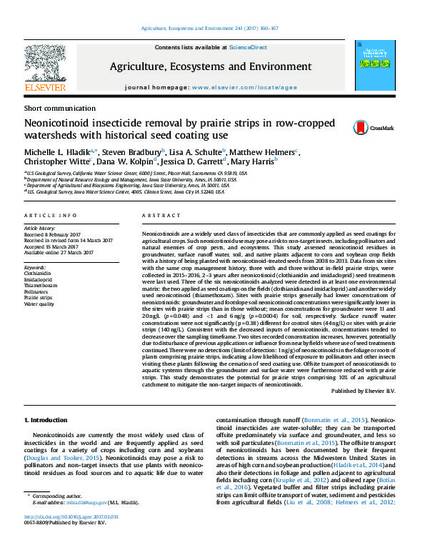
Neonicotinoids are a widely used class of insecticides that are commonly applied as seed coatings for agricultural crops. Such neonicotinoid use may pose a risk to non-target insects, including pollinators and natural enemies of crop pests, and ecosystems. This study assessed neonicotinoid residues in groundwater, surface runoff water, soil, and native plants adjacent to corn and soybean crop fields with a history of being planted with neonicotinoid-treated seeds from 2008 to 2013. Data from six sites with the same crop management history, three with and three without in-field prairie strips, were collected in 2015–2016, 2–3 years after neonicotinoid (clothianidin and imidacloprid) seed treatments were last used. Three of the six neonicotinoids analyzed were detected in at least one environmental matrix: the two applied as seed coatings on the fields (clothianidin and imidacloprid) and another widely used neonicotinoid (thiamethoxam). Sites with prairie strips generally had lower concentrations of neonicotinoids: groundwater and footslope soil neonicotinoid concentrations were significantly lower in the sites with prairie strips than in those without; mean concentrations for groundwater were 11 and 20 ng/L (p = 0.048) and /g (p = 0.0004) for soil, respectively. Surface runoff water concentrations were not significantly (p = 0.38) different for control sites (44 ng/L) or sites with prairie strips (140 ng/L). Consistent with the decreased inputs of neonicotinoids, concentrations tended to decrease over the sampling timeframe. Two sites recorded concentration increases, however, potentially due to disturbance of previous applications or influence from nearby fields where use of seed treatments continued. There were no detections (limit of detection: 1 ng/g) of neonicotinoids in the foliage or roots of plants comprising prairie strips, indicating a low likelihood of exposure to pollinators and other insects visiting these plants following the cessation of seed coating use. Offsite transport of neonicotinoids to aquatic systems through the groundwater and surface water were furthermore reduced with prairie strips. This study demonstrates the potential for prairie strips comprising 10% of an agricultural catchment to mitigate the non-target impacts of neonicotinoids.
Available at: http://works.bepress.com/steven_bradbury/66/

This article is published as Hladik, Michelle L., Steven Bradbury, Lisa A. Schulte, Matthew Helmers, Christopher Witte, Dana W. Kolpin, Jessica D. Garrett, and Mary Harris. "Neonicotinoid insecticide removal by prairie strips in row-cropped watersheds with historical seed coating use." Agriculture, Ecosystems & Environment 241 (2017): 160-167, doi: 10.1016/j.agee.2017.03.015.